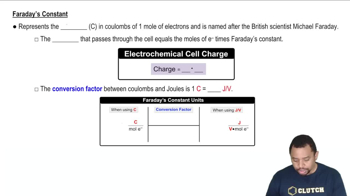Here are the essential concepts you must grasp in order to answer the question correctly.
Electrolysis
Electrolysis is a chemical process that uses electrical energy to drive a non-spontaneous reaction. In this process, an electric current is passed through an electrolyte, causing the decomposition of the compound. For molten LiCl, electrolysis results in the formation of lithium metal and chlorine gas at the electrodes. Understanding the principles of electrolysis is essential for calculating the mass of lithium produced.
Recommended video:
Faraday's Laws of Electrolysis
Faraday's Laws of Electrolysis quantify the relationship between the amount of substance produced at an electrode and the quantity of electric charge passed through the electrolyte. The first law states that the mass of a substance altered at an electrode is directly proportional to the total electric charge passed. This principle is crucial for calculating the mass of lithium formed in the given electrolysis scenario.
Recommended video:
Faraday's Constant in Electrochemistry
Electrolytic Cell Efficiency
The efficiency of an electrolytic cell refers to the ratio of the actual amount of product formed to the theoretical amount predicted by Faraday's laws. In this case, the cell is stated to be 85% efficient, meaning that only 85% of the theoretical lithium mass calculated from the charge is actually produced. This efficiency factor is vital for accurately determining the mass of lithium formed during the electrolysis process.
Recommended video:
 Verified step by step guidance
Verified step by step guidance


